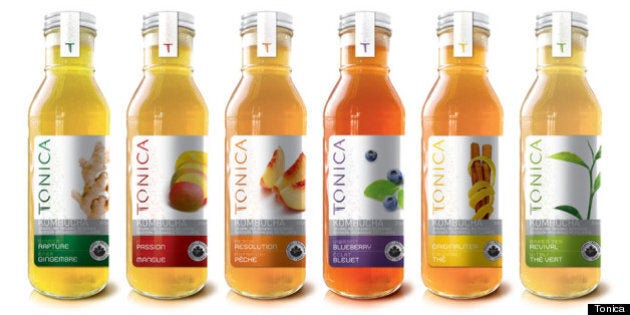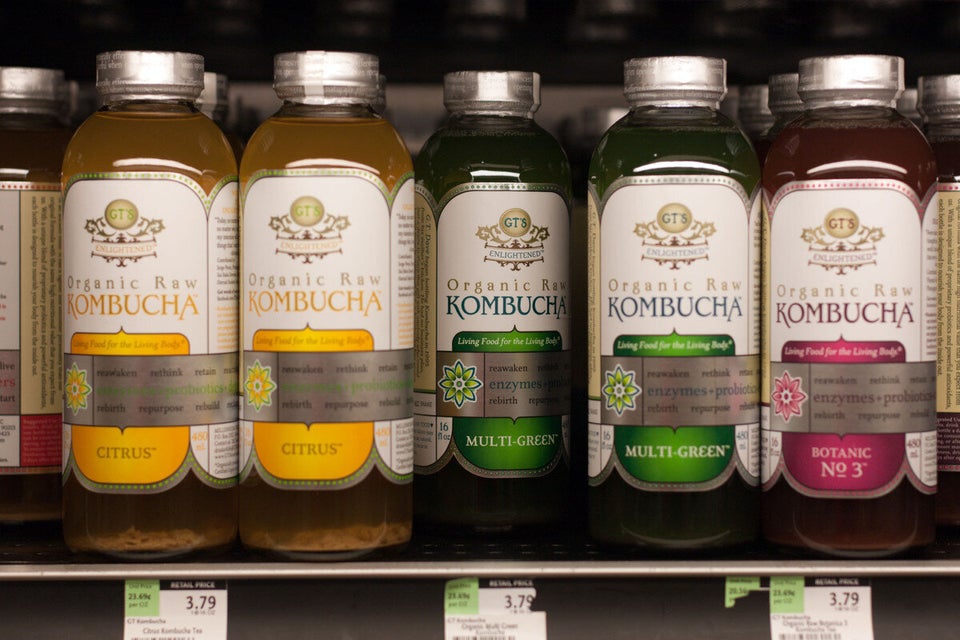
Kombucha is a fizzy, fermented beverage made from tea that is refreshing (especially as the weather heats up) but also great for you. The drink is essentially fermented tea: it's made from sweetened tea, usually black, that is fermented by a bacteria and yeast culture and ends up full of probiotics as a result.
Tea has been enjoying a surge of popularity for a few years now, due in part to its health benefits. And probiotics have gone from being a hippie supplement to finding their way into a wide variety of foods. Kombucha seems to indulge in both those trends for energizing tea and natural cultures that have been reported to boost digestion and metabolism at the same time.
There are health-based reasons to drink kombucha and it's much lower in sugar and calories than other sweet drinks, but it's also worth trying just for the taste. Emma Christensen first tried the fermented drink about five years ago—she was developing an interest in brewing beer at home, and a friend suggested she give kombucha a try. "It was just kind of love at first sip," said Christensen, a blogger and the author of True Brews: How to Craft Fermented Cider, Beer, Wine, Sake, Soda, Mead, Kefir, and Kombucha at Home "I loved how bright and tangy and fizzy it was. It was totally an unexpected treat."
Story continues below slideshow.
The history of kombucha isn't well known, but people in parts of the world like China, Tibet, Siberia, and Russia have been drinking it for thousands of years, according to About.com. It made its way to Germany around the turn of the last century, according to the American Cancer Society, and to the United States from there.
Kombucha is increasingly available everywhere from health-food stores to convenience markets, but if you're particularly ambitious you can even make it at home. Christensen offers a few recipes for customizing your own kombucha blend in her book, but the basic recipe is pretty straightforward: just tea, water, sugar, a SCOBY, and some time.
Read on for 11 things you need to know about kombucha, and you'll be ready to kick back with this delicious digestive aid—and maybe even start up a homemade brew of your own.
When You're Buying It In Stores, Look For Raw Kombucha
Pasteurization can kill the cultures that make kombucha what it is, so if you're buying a bottle in stores, look for a brand that's raw. Christensen likes GT's Kombucha, and Tonica (of Dragon's Den fame) is a popular Canadian brand.
It's Hailed As A Wonder Drink
Probiotics are produced as a byproduct of the reaction between the tea and the bacteria in the SCOBY, and they've got a host of benefits including prevention of diarrhea and improving digestion. Other health benefits attributed to kombucha include increased immunity, cancer prevention and improving liver function. However, there's no scientific evidence to support these health claims, according to the Mayo Clinic.
It's Slightly Boozy
Kombucha should have an alcohol content less than 0.5 per cent, unless it is left too long or refermented. The drink was pulled from shelves at Whole Foods in 2010 when there were concerns some bottles had sat too long and may have a higher-than-allowed percentage, but it reappeared after manufacturing changes.
You Can Make Kombucha At Home
To make homemade kombucha, Christensen sticks with a basic recipe: one cup of sugar in a gallon of water (3.79 litres), and eight bags (or two loose teaspoons) of black tea. Brew the tea as you normally would, then allow it to cool before adding your kombucha and your SCOBY—more on that next!—to a glass container. Cover and allow to brew for seven to 14 days. It's that simple!
You're Going To Need A SCOBY
SCOBY stands for symbiotic culture of bacteria and yeast, which is what turns sugary tea into kombucha. "It feels kind of like a rubbery pancake," Christensen said of the beige cellulose disc that contains the yeast and bacteria that ferments and cultures kombucha. The yeast in the SCOBY—sometimes called a mother or mushroom, though it's not a fungus—eats the sugar in your tea, and the bacteria works with some of the enzymes and other nutrients and makes probiotics as a byproduct, she said.
Don't Have A SCOBY? Grow Your Own!
If you don't have a SCOBY, you can make your own using the tea and sugar brew and some store-bought plain kombucha. Mix the two together in a glass container, cover with cheesecloth, and let sit for 10 to 20 days to let the SCOBY grow. "It'll look pretty weird at first," Christensen warned. "It can look kind of like a seventh-grade science project." When the SCOBY is a quarter of an inch thick, remove it and use it to make your kombucha.
You can also buy a SCOBY online. Cultures for Health is one of many sites selling them.
One SCOBY Can Last For Years
Christensen started brewing her own kombucha three or four years ago and is still working from her original SCOBY. She peels off the bottom layer, which is the oldest, when the SCOBY gets too large; this layer can be given to someone else so they can start their own kombucha production using it. "As long as you take care of it, it'll last forever," she said about SCOBYs.
It's Easy To Add Your Own Flavours
Stick with caffeinated teas. The decaffeination process changes the tea's makeup in a way that will affect your final product and you'll miss out on some of the drink's benefits, Christensen said. But feel free to branch out from black—oolong and green tea can also be used. "Green tea makes a light and fruity flavoured kombucha," Christensen said.
Once your kombucha is brewed, you can experiment with adding different flavours by infusing it with fruits or herbs. Christensen likes to infuse her kombucha with fruits for a day or two, and then strain the pieces out. "It's a lot of fun once you get into making your own kombucha."
It's Pretty Hard To Screw It Up
It might feel difficult to know if your SCOBY is right or your tea is fermenting properly, especially because these days we're not used to growing live cultures in our kitchens on purpose. A bad SCOBY or batch is usually pretty clear; the smell will be of or the SCOBY will develop black spots or grow mold. "People that people have been brewing kombucha for centuries under far less sanitary conditions that anyone's gonna have in their own kitchen," Christensen said.
Consistency Is Key
It's best to keep the recipe you use with one particular SCOBY—for example, for black tea—as consistent as possible. For example, try to use each SCOBY with only one kind of tea: black, green, etc.
It Might Not Be For Everyone
Take care to keep your kombucha from becoming contaminated, and if your SCOBY gets moldy or turns black, discard it and your batch of kombucha and start over. Make sure your supplies are well cleaned to avoid introducing the kind of bacteria you don't want in your drink. If you are pregnant or have a compromised immune system, talk to a health professional before drinking raw kombucha.
